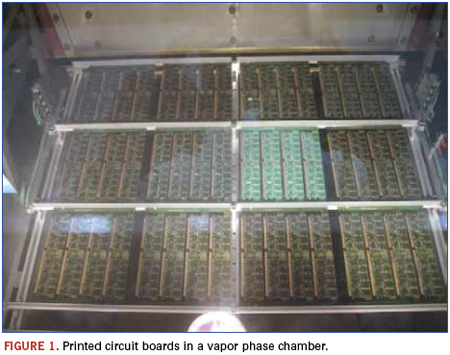The Virtues of Vapor
Our newest columnist extols the low energy use and repeatability of VPS.
Vapor phase achieves a very gentle, reliable and repeatable reflow process. Due to its excellent heat transfer capability, vapor phase systems typically consume low amounts of electricity and Galden fluid. (Galden refers to the inert, fluorinated fluids used for heat transfer in vapor phase soldering machines.) Vapor phase machines also tend to have low operational costs and maintenance requirements. They use two chambers and cooling systems to help prevent the escape of vapor and heat. The vapor is under constant condensation and recirculates to minimize fluid consumption. Galden liquid is non-aggressive, noncorrosive, non-electrically conducive, completely inert, and environmentally friendly. It is important to mention that Galden has no expiration, and the material never has to be replaced or disposed.
The power consumption of a vapor phase machine is much lower than any other reflow systems. Higher-end machines use an average of 10 KVA per hour, much lower than any forced convection reflow ovens. A vapor phase machine utilizes 98% of the heat created to heat the assembly, whereas for other reflow processes much of the heat created is not utilized to heat the assembly. Instead, the heat escapes other reflow systems, adding to plant air conditioning costs. Recommended maintenance can be as infrequent as once a year for a single-shift operation and twice a year for a two-shift operation. Preventive maintenance costs also tend to be very low because the main parts are situated outside the heating chambers.
There is a misconception that the cost of Galden fluid increases operating expenses. However, advancements in vapor phase machines have served to minimize fluid consumption. In addition to the electricity savings and nitrogen savings, VPS eliminates yet another cost. Nitrogen use is very expensive, and it requires additional process control and storage. With vapor phase, the atmosphere is inherently completely inert (oxygen-free), providing huge cost savings for companies that use nitrogen.
Vapor phase is an ideal solution for the transition to Pb-free. Pb-free solders tend to have higher melting points. Overheating components and assemblies is physically impossible due to the boiling point of the Galden. The even heat transfer results in much lower peak temperatures and lower delta Ts. Overheated and damaged components can have short-term and long-term cost impacts. Also, due to the even heat transfer, a high-mix environment requires fewer profiles. If coupled with real-time profiling capabilities, no additional external profiler is required. With temperature-driven process control, the profiles are repeatable all the time, and there are fast changeovers even, from leaded and Pb-free processes.
For prototypes and small-volume production, tabletop and batch vapor phase systems have a much smaller footprint than other reflow systems. In a tabletop unit, BGAs and fine-pitch components in Pb-free assemblies can be soldered with very low delta Ts and very low peak temperatures. In addition to the floor space savings, these smaller tabletop units use only 1.5 KVA per hour.

Ed. note: This continues our series on various machine soldering processes. To date, we’ve covered convection reflow, wave and selective. Since 2009, Jochen Lipp has been CEO of IBL Technologies, a maker of inline vapor phase soldering equipment. Prior to joining IBL, he spent nearly 10 years as vice president of operations and COO of Epic Technologies, a multinational EMS firm, where he developed and implemented the EPIC Synchronous Flow Model.
Jochen Lipp is CEO of IBL Technologies (ibl-tech.com); j.lipp@ibl-tech.com. His column will run bimonthly.







